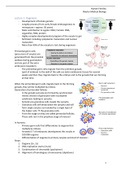Samenvatting
Samenvatting Human Fertility (NWI-BM050B)
- Instelling
- Radboud Universiteit Nijmegen (RU)
Summary of all lectures given in 2022. My own score with learning my own summary for this exam was scored 8.2/10. Good luck with your exam!
[Meer zien]





